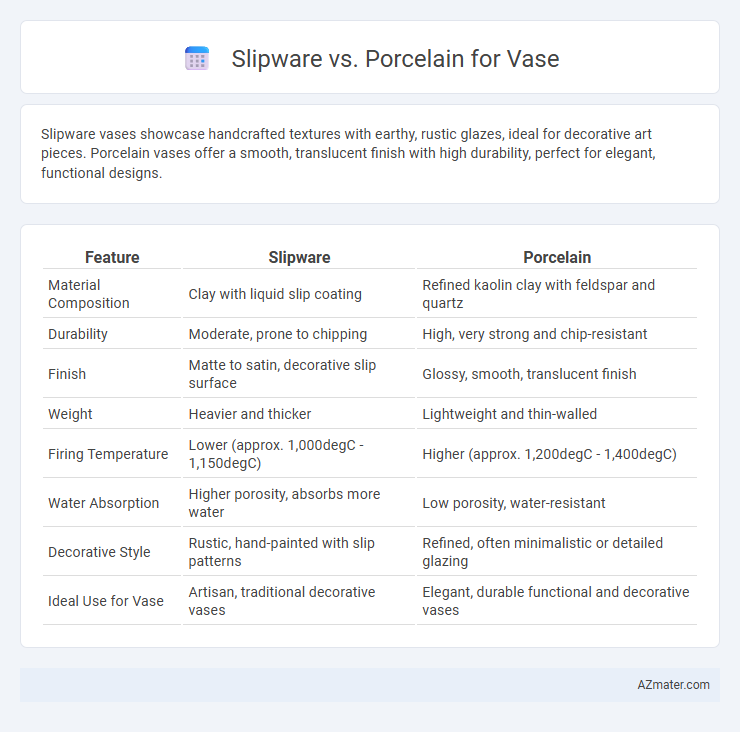Slipware vases showcase handcrafted textures with earthy, rustic glazes, ideal for decorative art pieces. Porcelain vases offer a smooth, translucent finish with high durability, perfect for elegant, functional designs.
Table of Comparison
| Feature | Slipware | Porcelain |
|---|---|---|
| Material Composition | Clay with liquid slip coating | Refined kaolin clay with feldspar and quartz |
| Durability | Moderate, prone to chipping | High, very strong and chip-resistant |
| Finish | Matte to satin, decorative slip surface | Glossy, smooth, translucent finish |
| Weight | Heavier and thicker | Lightweight and thin-walled |
| Firing Temperature | Lower (approx. 1,000degC - 1,150degC) | Higher (approx. 1,200degC - 1,400degC) |
| Water Absorption | Higher porosity, absorbs more water | Low porosity, water-resistant |
| Decorative Style | Rustic, hand-painted with slip patterns | Refined, often minimalistic or detailed glazing |
| Ideal Use for Vase | Artisan, traditional decorative vases | Elegant, durable functional and decorative vases |
Introduction to Slipware and Porcelain Vases
Slipware vases feature a decorative technique using liquid clay slip applied to create intricate patterns and textures, making each piece uniquely artistic and tactile. Porcelain vases, known for their fine, translucent quality and high-fired strength, offer a smooth, glossy finish that emphasizes elegance and durability. The choice between slipware and porcelain vases depends on desired aesthetic, functionality, and traditional craftsmanship preferences.
Historical Background of Slipware and Porcelain
Slipware pottery originated in ancient Mesopotamia around 3000 BCE, utilizing liquid clay slip to create intricate designs and textures, influencing ceramic art across Europe during the medieval and Renaissance periods. Porcelain, developed in China during the Tang dynasty (618-907 CE) and perfected in the Song dynasty (960-1279 CE), became prized for its translucency, strength, and delicate glazing, transforming global ceramic production. Both slipware and porcelain reflect distinct technological advancements and cultural aesthetics that shaped vase making through centuries.
Material Composition and Production Techniques
Slipware vases feature earthenware clay coated with liquid clay slip, creating distinct surface textures and patterns through hand-painting or trailing techniques. Porcelain vases are made from refined kaolin clay fired at high temperatures, resulting in a dense, translucent, and durable material. Slipware production emphasizes artisanal, decorative finishes, while porcelain requires precise control of kiln conditions for its smooth, glass-like surface.
Aesthetic Differences Between Slipware and Porcelain
Slipware vases feature a rustic, textured surface achieved by applying liquid clay slip, often decorated with bold, earthy patterns that emphasize a handcrafted, organic aesthetic. Porcelain vases, in contrast, exhibit a smooth, translucent finish with a refined, glossy appearance that highlights precision and delicate craftsmanship. The tactile contrast between slipware's matte, patterned surfaces and porcelain's sleek, polished look defines their distinct visual appeal in ceramic art.
Durability and Functional Qualities
Slipware vases, made by applying liquid clay slip onto a ceramic body, offer a rustic aesthetic with moderate durability suitable for decorative purposes. Porcelain vases, crafted from dense kaolin clay fired at high temperatures, provide superior durability, resistance to chipping, and water impermeability, making them ideal for functional use such as holding water and flowers. The non-porous surface of porcelain ensures long-lasting structural integrity, while slipware may require sealing to enhance its moisture resistance.
Artistic Expression and Cultural Significance
Slipware vases showcase vibrant, textured surfaces created through the application of liquid clay slip, emphasizing artisanal craftsmanship and folk art traditions deeply rooted in various cultures. Porcelain vases, prized for their smooth, translucent finish and delicate, refined forms, embody elegance and sophistication associated with imperial and high-culture art histories. Artistic expression in slipware often reflects rustic, bold designs and cultural storytelling, while porcelain highlights precision, subtlety, and a timeless aesthetic revered in global ceramic art.
Price and Market Value Comparison
Slipware vases typically cost less than porcelain due to their handcrafted, rustic production methods, making them attractive for budget-conscious collectors. Porcelain vases command higher market value because of their durable, refined material and intricate designs, often favored in luxury decor markets. The price gap reflects porcelain's demand in both antiques and contemporary art markets, whereas slipware appeals more to niche, artisanal collectors.
Suitability for Different Home Decor Styles
Slipware vases offer a rustic, artisanal charm ideal for farmhouse, bohemian, and eclectic home decor styles due to their textured surfaces and earthy tones. Porcelain vases, known for their smooth finish and delicate appearance, complement modern, minimalist, and traditional interiors by adding elegance and subtle sophistication. Selecting between slipware and porcelain depends on the desired aesthetic, with slipware enhancing casual, cozy spaces and porcelain elevating refined, polished environments.
Maintenance and Care Tips
Slipware vases require gentle handling and should be cleaned with a soft cloth and mild soap to prevent damage to the decorative slip coating, avoiding abrasive materials that can scratch the surface. Porcelain vases are more durable and resistant to stains, allowing for easier maintenance with regular dusting and occasional washing using warm water and non-abrasive cleaners. Both materials benefit from being kept away from extreme temperature changes and direct sunlight to preserve their finish and structural integrity.
Choosing the Right Vase: Slipware or Porcelain?
Slipware offers a rustic, handcrafted aesthetic characterized by its textured surface and earthy glazes, making it ideal for vases that emphasize artisanal charm and organic appeal. Porcelain, known for its smooth, translucent quality and durability, suits vases requiring an elegant, refined look with a polished finish. Choosing between slipware and porcelain for a vase depends on whether you prioritize natural, tactile artistry or sleek, sophisticated design.

Infographic: Slipware vs Porcelain for Vase
 azmater.com
azmater.com